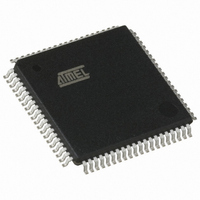AT89C5132-ROTUL Atmel, AT89C5132-ROTUL Datasheet - Page 37

AT89C5132-ROTUL
Manufacturer Part Number
AT89C5132-ROTUL
Description
IC 8051 MCU FLASH 64K USB 80TQFP
Manufacturer
Atmel
Series
AT89C513xr
Specifications of AT89C5132-ROTUL
Core Processor
C52X2
Core Size
8-Bit
Speed
20MHz
Connectivity
IDE/ATAPI, I²C, MMC, PCM, SPI, UART/USART, USB
Peripherals
I²S, POR, WDT
Number Of I /o
44
Program Memory Size
64KB (64K x 8)
Program Memory Type
FLASH
Eeprom Size
4K x 8
Ram Size
2.25K x 8
Voltage - Supply (vcc/vdd)
2.7 V ~ 3.3 V
Data Converters
A/D 2x10b
Oscillator Type
Internal
Operating Temperature
-40°C ~ 85°C
Package / Case
80-TQFP, 80-VQFP
Cpu Family
89C
Device Core
8051
Device Core Size
8b
Frequency (max)
40MHz
Interface Type
IDE/SPI/UART/USB
Total Internal Ram Size
2.25KB
# I/os (max)
44
Number Of Timers - General Purpose
2
Operating Supply Voltage (typ)
3V
Operating Supply Voltage (max)
3.3V
Operating Supply Voltage (min)
2.7V
On-chip Adc
2-chx10-bit
Instruction Set Architecture
CISC
Operating Temp Range
-40C to 85C
Operating Temperature Classification
Industrial
Mounting
Surface Mount
Pin Count
80
Package Type
TQFP
Package
80TQFP
Family Name
89C
Maximum Speed
40 MHz
Operating Supply Voltage
3 V
Data Bus Width
8 Bit
Number Of Programmable I/os
44
Number Of Timers
2
Maximum Clock Frequency
20 MHz
Data Ram Size
2304 B
Mounting Style
SMD/SMT
A/d Bit Size
10 bit
A/d Channels Available
2
Height
1.45 mm
Length
14.1 mm
Maximum Operating Temperature
+ 85 C
Minimum Operating Temperature
- 40 C
Supply Voltage (max)
3.3 V
Supply Voltage (min)
2.7 V
Width
14.1 mm
For Use With
AT89OCD-01 - USB EMULATOR FOR AT8XC51 MCU
Lead Free Status / RoHS Status
Lead free / RoHS Compliant
Available stocks
Company
Part Number
Manufacturer
Quantity
Price
10.2
10.2.1
10.2.2
10.2.3
4173E–USB–09/07
External Interrupts
INT1:0 Inputs
KIN3:0 Inputs
Input Sampling
External interrupts INT0 and INT1 (INTn, n = 0 or 1) pins may each be programmed to be level-
triggered or edge-triggered, dependent upon bits IT0 and IT1 (ITn, n = 0 or 1) in TCON register
as shown in Figure 10-2. If ITn = 0, INTn is triggered by a low level at the pin. If ITn = 1, INTn is
negative-edge triggered. External interrupts are enabled with bits EX0 and EX1 (EXn, n = 0 or 1)
in IEN0. Events on INTn set the interrupt request flag IEn in TCON register. If the interrupt is
edge-triggered, the request flag is cleared by hardware when vectoring to the interrupt service
routine. If the interrupt is level-triggered, the interrupt service routine must clear the request flag
and the interrupt must be deasserted before the end of the interrupt service routine.
INT0 and INT1 inputs provide both the capability to exit from Power-down mode on low level sig-
nals as detailed in Section “Exiting Power-down Mode”, page 47.
Figure 10-2. INT1:0 Input Circuitry
External interrupts KIN0 to KIN3 provide the capability to connect a matrix keyboard. For
detailed information on these inputs, refer to Section “Keyboard Interface”, page 152.
External interrupt pins (INT1:0 and KIN3:0) are sampled once per peripheral cycle (6 peripheral
clock periods) (see Figure 10-3). A level-triggered interrupt pin held low or high for more than 6
peripheral clock periods (12 oscillator in standard mode or 6 oscillator clock periods in X2 mode)
guarantees detection. Edge-triggered external interrupts must hold the request pin low for at
least 6 peripheral clock periods.
Figure 10-3. Minimum Pulse Timings
INT0/1
Level-Triggered Interrupt
Edge-Triggered Interrupt
TCON.0/2
IT0/1
0
1
1 cycle
> 1 peripheral cycle
> 1 peripheral cycle
TCON.1/3
1 cycle
1 cycle
IE0/1
IEN0.0/2
EX0/1
AT89C5132
INT0/1
Interrupt
Request
37














